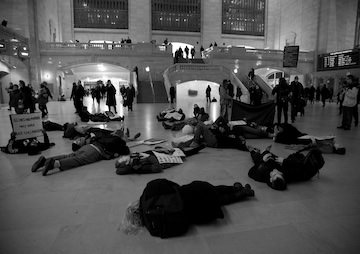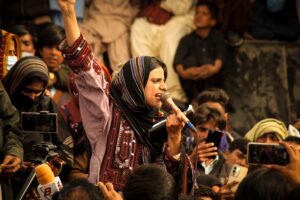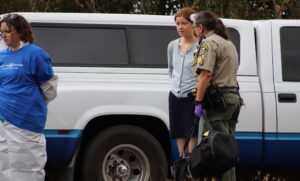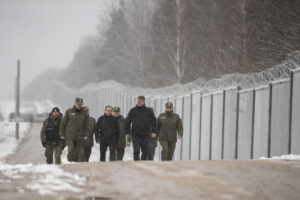Documents Reveal NYPD Infiltrated Black Lives Matter
The surveillance was uncovered after a protester filed a Freedom of Information request about demonstrations in 2014 and 2015.
Protesters demonstrate at New York’s Grand Central Terminal over the 2014 chokehold death of Eric Garner. (Tina Leggio / CC BY-NC-ND 2.0)
The New York Police Department infiltrated Black Lives Matter groups and gained access to organizers’ text messages, according to recently revealed documents. The information came to light after a protester, James Logue, filed a request under the Freedom of Information law asking the NYPD to provide documents and video surveillance of 2014 and 2015 Black Lives Matter demonstrations over the chokehold death of Eric Garner.
The NYPD originally denied the request, claiming that public disclosure would reveal its tactics and “interfere with law enforcement work,” the New York Daily News reports. New York County Supreme Court Justice Manuel Mendez overruled the police department.
The Guardian obtained the documents from New York law firm Stecklow & Thompson and learned how NYPD gathered intelligence on Black Lives Matter activists and their actions.
The Guardian reports:
Emails show that undercover officers were able to pose as protesters even within small groups, giving them extensive access to details about protesters’ whereabouts and plans. In one email, an official notes that an undercover officer is embedded within a group of seven protesters on their way to Grand Central Station. This intimate access appears to have helped police pass as trusted organizers and extract information about demonstrations. In other emails, officers share the locations of individual protesters at particular times. The NYPD emails also include pictures of organizers’ group text exchanges with information about protests, suggesting that undercover officials were either trusted enough to be allowed to take photos of activists’ phones or were themselves members of a private planning group text. …
Joseph Giacalone, a retired NYPD detective sergeant and professor at John Jay College, agreed that it would not be easy for an undercover officer to join a small group of protesters and hear their plans. “It would be pretty amazing that they would be able to get into the core group in such a short window of time,” said Giacalone. “This could have been going on a while before for these people to get so close to the inner circle.”
The NYPD documents also included a handful of pictures and one short video taken at Grand Central Station demonstrations. Most are pictures of crowds milling about or taking part in demonstrations. In one picture of a small group of activists, the NYPD identifies an individual in a brown jacket as the “main protester”. These images of protesters are reminiscent of those taken by undercover transit police, who were also deployed to Black Lives Matter protests in Grand Central Station in 2015.
Giacalone said this type of leadership identification was standard police practice at protests. “If you take out the biggest mouth, everybody just withers away, so you concentrate on the ones you believe are your organizers,” he said. “Once you identify that person, you can run computer checks on them to see if they have a warrant out or any summons failures, then you can drag them in before they go out to speak or rile up the crowd, as long as you have reasonable cause to do so.”
David Thompson, an attorney with Stecklow & Thompson who helped acquire the NYPD documents, was dismayed by the department’s actions. “The documents uniformly show no crime occurring,” Thompson told The Guardian. “But NYPD had undercovers inside the protests for months on end as if they were al-Qaida.”
Crackdowns on civil liberties and invasions of privacy have become a trend in America. Days before Donald Trump took office as president, the Obama administration passed new rules allowing the National Security Agency to share all the private data it has gathered over the years, without warrant, court orders or congressional authorization, with 16 other agencies. These agencies include the FBI, Drug Enforcement Administration and Department of Homeland Security.
Lawmakers in 18 states have also introduced legislation to curb mass protests.
In March, a hearing of the House Committee on Oversight and Government Reform revealed that the FBI broke laws by implementing facial recognition technology without oversight. The agency has collected photos of 50 percent of all adult citizens in the United States and put them in electronic databases accessible to local law enforcement across the country.
“This is really Nazi Germany here,” Rep. Stephen Francis Lynch, D-Mass., said at the hearing. “[The Nazis] had meticulous files on individuals. Most of them of Jewish faith, and that’s how they tracked their people. I see little difference in the way people are being tracked under this.”
Undercover targeting of protesters isn’t limited to Black Lives Matter. Reports indicate that the FBI has targeted Dakota Access pipeline protesters, or “water protectors,” in North Dakota and spied on Occupy Wall Street activists.
Independent journalism is under threat and overshadowed by heavily funded mainstream media.
You can help level the playing field. Become a member.
Your tax-deductible contribution keeps us digging beneath the headlines to give you thought-provoking, investigative reporting and analysis that unearths what's really happening- without compromise.
Give today to support our courageous, independent journalists.






You need to be a supporter to comment.
There are currently no responses to this article.
Be the first to respond.